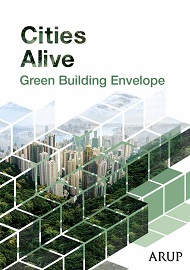Green building envelope
Contents |
[edit] Introduction
In September 2016, Arup published ‘Cities Alive: Green Building Envelope’, a report examining the possibilities of cleaner, greener and healthier human ecosystems.
The report, written by a global collaborative team of Arup specialists, explores the application of green infrastructure to the surfaces of both new and existing inner-city buildings in five major cities; Berlin, London, Los Angeles, Melbourne and Hong Kong.
The wide-ranging conclusions of the report include:
[edit] Air pollution
- Green facades can reduce local air pollution by 10-20%.
- The level of reduction is dependent on the ratio of the building height to the street width.
[edit] Acoustics
- Green facades could reduce sound levels from emergent and traffic noise sources by up to 10dB(A).
- Green facades have a greater acoustical impact with increasing distance from the noise source.
- When ambient noise levels are lower, such as during the night, green facades are likely to have a greater acoustic impact.
[edit] Urban heat island (UHI) effect
- Green facades can remove 50% of solar radiation.
- They are most effective at reducing the UHI in denser urban centres and in areas where there is more concrete and less planting.
- Reductions in peak air temperatures of up to 10ºC are achievable, although for most areas, the mean reductions in UHI were a fraction of a degree compared to the peak.
- Cities with wide streets and low-rise buildings could benefit from more greenery at street level.
To download the full report for free, see Arup.
[edit] Find out more
[edit] Related articles on Designing Buildings Wiki
Featured articles and news
RTPI leader to become new CIOB Chief Executive Officer
Dr Victoria Hills MRTPI, FICE to take over after Caroline Gumble’s departure.
Social and affordable housing, a long term plan for delivery
The “Delivering a Decade of Renewal for Social and Affordable Housing” strategy sets out future path.
A change to adoptive architecture
Effects of global weather warming on architectural detailing, material choice and human interaction.
The proposed publicly owned and backed subsidiary of Homes England, to facilitate new homes.
How big is the problem and what can we do to mitigate the effects?
Overheating guidance and tools for building designers
A number of cool guides to help with the heat.
The UK's Modern Industrial Strategy: A 10 year plan
Previous consultation criticism, current key elements and general support with some persisting reservations.
Building Safety Regulator reforms
New roles, new staff and a new fast track service pave the way for a single construction regulator.
Architectural Technologist CPDs and Communications
CIAT CPD… and how you can do it!
Cooling centres and cool spaces
Managing extreme heat in cities by directing the public to places for heat stress relief and water sources.
Winter gardens: A brief history and warm variations
Extending the season with glass in different forms and terms.
Restoring Great Yarmouth's Winter Gardens
Transforming one of the least sustainable constructions imaginable.
Construction Skills Mission Board launch sector drive
Newly formed government and industry collaboration set strategy for recruiting an additional 100,000 construction workers a year.
New Architects Code comes into effect in September 2025
ARB Architects Code of Conduct and Practice available with ongoing consultation regarding guidance.
Welsh Skills Body (Medr) launches ambitious plan
The new skills body brings together funding and regulation of tertiary education and research for the devolved nation.
Paul Gandy FCIOB announced as next CIOB President
Former Tilbury Douglas CEO takes helm.
UK Infrastructure: A 10 Year Strategy. In brief with reactions
With the National Infrastructure and Service Transformation Authority (NISTA).























